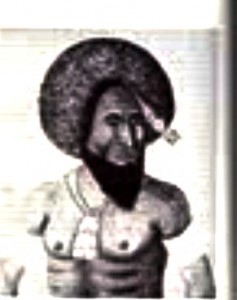
Vendovi, Chief of the Rewa
By Tom Welch
Vendovi, Chief of Rewa
Perhaps one of the least-known of the 172 islands in the San Juan Islands, Vendovi Island lies 7 miles north of Anacortes, in Skagit County. Situated between Guemes and Lummi Islands, Vendovi Island has just over 220 acres of land and 13,000 feet of shoreline. With a population of two (2000 census), Vendovi was a privately-owned island until its purchase for $6.4 million by the San Juan Preservation Trust in 2010.
Vendovi Island was named by Charles Wilkes, Commander of the U.S. Exploring Expedition, for a savage chief of the Fiji Islands. Vendovi, Chief of Rewa, had been targeted by the expedition as the man responsible for the 1833 murder and cannibalism of the crew of the U.S. whaling vessel “Charles Daggett.” Arrested during their survey of the Fiji Islands, Vendovi was taken aboard ship and eventually brought back to the United States by the Expedition. Although he was meant to be put on trial for killing and eating the whaler’s crew, Vendovi was in poor health by the time the Expedition anchored in New York harbor on June 8,1842, and he died a day after they arrived.
At the time of his death, Vendovi had been a captive for nearly two years. A powerful chief when he was arrested by the Expedition, Vendovi had led a regal life, with fifty wives and more than fifty slaves. His great hairdo, groomed daily by twelve personal servants, became entangled and filthy after his capture, and was soon cut off by the Expedition barber. Granted the run of the ship, he became a well-respected member of the ships company during his time aboard. Regal and quite haughty in manner, particularly to those natives encountered during his time with the Expedition, Vendovi was particularly dismissive of the Lummi and other local Indian tribes, refusing to acknowledge them in any way. The Expedition log made particular note of his dismissive attitude towards the natives, remarking that he found them beneath contempt, and would have nothing to do with them.
The discovery of Antarctica, the first mapping and survey of the South Sea islands, and the first charts and maps of the Pacific Northwest, including the inland waters of Washington, were among the signal accomplishments of this first expression of American naval power. Surveying the San Juan Islands and surrounding waters from May to July, 1841, the crew of the U.S. Exploring Expedition named many of the islands, and other geographic features, for American naval heroes of the War of 1812. Decatur, Sinclair, Shaw, Blakely, and Jones Islands were all named by the Expedition, as well as Mt. Constitution on Orcas Island. Other names, including Hull’s Island (Orcas), Rodger’s Island (San Juan), and Chauncey’s Island (Lopez), were changed back to the original Spanish names by a later British survey. Vendovi was among the island names bestowed by Wilkes that survived the change.
The huge amount of artifacts and objects brought back to the United States by the U.S. Exploring Expedition was intended for public exhibition, but no museum in the country was large enough to contain this unique treasure trove of science. Moved to create a ‘national’ museum, the government accepted the gift of money offered by James Smithson, and the art, artifacts, and objects collected on that epic voyage became the foundation collection of the Smithsonian Institution.
Somewhere among the collection lies the head of Vendovi, Chief of Rewa: true to their scientific calling, the members of the expedition had removed his head after he died and placed it among the objects for exhibition. Perhaps more a victim of his times than his crimes, Vendovi, Chief of Rewa, continues to hold a prominent place in our beloved San Juan Islands.
**If you are reading theOrcasonian for free, thank your fellow islanders. If you would like to support theOrcasonian CLICK HERE to set your modestly-priced, voluntary subscription. Otherwise, no worries; we’re happy to share with you.**








Excellent history review of a neighboring island and the characters, discoveries and artifacts that defined the time.
Help us please. I have written to a Mr Leyman on this.
I am married to a descendant of Ro Veidovi Logavatu (His full name). He hails from a long line of Chiefs known as the Rokotuidreketi in the village of Lomanikoro in the Rewa district of Fiji.
From Ro Veidovi it has now somehow changed to Vendovi.
My family would like to visit this so called exhibition “of his head” and submit a plea of help in getting Ro veidovi home.
For years we have been trying to do this. Get him home and give him a proper burial.
No body in his right mind would like a display of his relatives head in a museum for everybody to gawk at.
Please someone over there in Orca Island, management of the exhibition and artwork gallery and executives.. help us get our ancestor home for a proper funeral. He has been punished enough by the US Government to a stage of inhumanity for crimes committed during tribal wars in Fiji…Help!